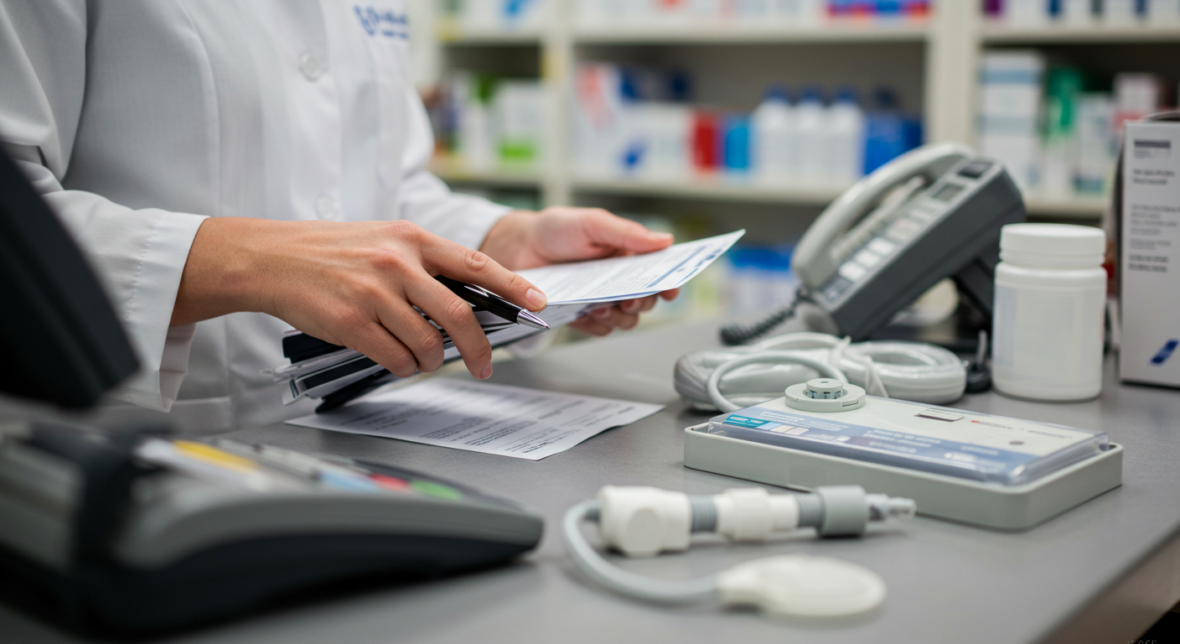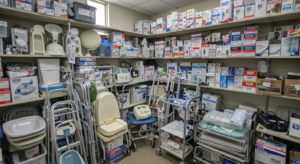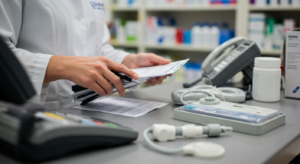A Pharmacist’s Guide to DME Billing: Transforming Your Business Through Medicare Part B
*Note: This guide uses the fictional story of Mae Whelan and Whelan’s Pharmacy to illustrate the real opportunities and challenges in DME billing. While Mae’s story is fictional, it represents the actual experiences of many independent pharmacies implementing DME programs.*
It’s a typical Tuesday morning at Whelan’s Pharmacy when Mrs. Johnson walks in, prescription in hand for a continuous glucose monitor (CGM). Mae Whelan, the owner, has seen countless similar prescriptions over her twenty years as a pharmacist. Like many of her colleagues, she’s always processed these through prescription insurance – but today is different. Today, she’s about to discover a game-changing approach to serving her patients while significantly boosting her pharmacy’s revenue.

The Hidden Opportunity in Plain Sight
The story of Whelan’s Pharmacy’s transformation begins with that single CGM prescription. As Mae reviewed Mrs. Johnson’s Medicare coverage, she remembered a recent conversation with a colleague about billing certain medical equipment through Medicare Part B instead of traditional prescription coverage. What she discovered would revolutionize her approach to serving her community’s medical equipment needs.
The advantages of Medicare Part B billing quickly became clear:
- Higher reimbursement rates – typically 20-30% higher for items like CGMs
- Reduced competition from other pharmacies in the area
- Opportunity to provide more comprehensive patient care
- Stronger relationships with local healthcare providers
“I never realized we were leaving money on the table,” Mae reflects. “When I found out that Medicare Part B typically offers 20-30% higher reimbursement rates for CGMs compared to prescription benefits, I knew we needed to make a change.”
A New Chapter in Patient Care
The decision to venture into Durable Medical Equipment (DME) billing wasn’t just about improved reimbursement. For Mae, it opened up an entirely new way of serving her community. Instead of simply dispensing equipment, her pharmacy became a comprehensive care center for medical equipment needs.
Sarah, Mae’s lead technician, now spends time with each DME patient, ensuring they understand how to use their equipment properly. “The other day, I spent an hour with Mr. Davis, teaching him how to use his new nebulizer,” she shares. “The look of relief on his face when he finally felt confident using it independently – that’s what makes this work meaningful.”
Building the Program: One Step at a Time
Mae’s journey into DME billing began strategically. Rather than diving into complex equipment categories, she started with what she calls the “confidence builders” – straightforward items that allowed her team to master the basics of DME billing while maintaining their confidence.
Mae’s Strategic Product Implementation:
- Tier 1 (Starting Point): Simple items like nebulizers, walkers, and canes
- Tier 2 (After 3 months): CGMs, blood glucose supplies, and compression stockings
- Tier 3 (After 6 months): More complex items like CPAP devices and hospital beds
Each tier required additional training and documentation processes, but the graduated approach helped her team build confidence and expertise.
“We learned quickly that success in DME isn’t about offering everything at once,” Mae explains. “It’s about building a strong foundation and growing thoughtfully.” After mastering the basics, Whelan’s Pharmacy gradually expanded into more complex offerings like CGMs, compression stockings, and eventually, CPAP devices.
Navigating the Technical Waters
The technical aspects of DME billing initially seemed daunting. Medicare enrollment requirements, documentation needs, and claim processing all presented new challenges. However, Mae found that modern technology could transform these potential obstacles into manageable processes.
Using DocStation’s platform, Whelan’s Pharmacy streamlined their DME operations. What once required hours of paperwork now flows smoothly through digital systems. The platform transformed several key challenges:
Key Technical Solutions:
- Automated documentation management for face-to-face encounters and proof of delivery
- Streamlined claim processing with built-in Medicare requirement checks
- Integrated inventory tracking for rental equipment and serial numbers
- Automated compliance monitoring and reporting
- Real-time payment tracking and denial management
“The platform handles everything from documentation to claim processing,” Mae notes. “It’s like having an extra team member who never makes mistakes.”
The Valley Pharmacy Success Story
Mae’s experience mirrors that of Valley Pharmacy, another independent pharmacy that embraced DME billing. Within their first year of implementing a DME program through DocStation’s platform, they saw their CGM-related revenue increase by 40%. More importantly, they strengthened their role as a healthcare destination in their community.
Looking to the Future
The DME market is projected to reach $92.70 billion by 2030, driven by an aging population and increasing chronic disease prevalence. For independent pharmacies, this represents more than just numbers – it’s an opportunity to evolve and better serve their communities.
Mae now mentors other pharmacists beginning their DME journey. Her advice is simple: “Start small, but dream big. Every journey in DME begins with a single claim, but it can transform your entire practice.”
For pharmacists ready to explore DME billing, the path is clearer than ever. With the right technology partner and a patient-focused approach, independent pharmacies can write their own success stories in this growing field. The future of pharmacy isn’t just about dispensing medications – it’s about providing comprehensive care solutions that truly serve community needs.
As Mrs. Johnson returns to Whelan’s Pharmacy for her quarterly CGM supplies, she’s greeted by name and receives not just her equipment, but also the care and attention that have become hallmarks of Mae’s DME program. This is the future of independent pharmacy, and it’s happening one patient at a time.







